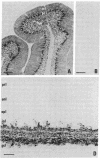Abstract
Five monoclonal antibodies that recognize chicken brain glutamic acid decarboxylase (GAD) have been selected and designated GAD-1 to -5. GAD-1 to -5 were selected on the basis of their ability to immunoprecipitate active GAD from crude brain extracts. GAD-1 recognizes an epitope that is conserved in many vertebrates; the epitope recognized by GAD-5 is restricted to the chicken. Radioimmunoassays with GAD-1 indicate that GAD is highly enriched in brain relative to other tissues. GAD was localized immunocytochemically with GAD-1 and GAD-2 in rat cerebellum, spinal cord, and retina. The staining pattern is in agreement with that obtained previously with polyclonal antisera to GAD. GAD from the chicken brain was purified by chromatography on an immunoaffinity column made of GAD-1. NaDodSO4/PAGE analysis of the immunoaffinity-purified GAD fractions shows a major band of 59 kDa and minor bands at 63 and 54 kDa.
Full text
PDF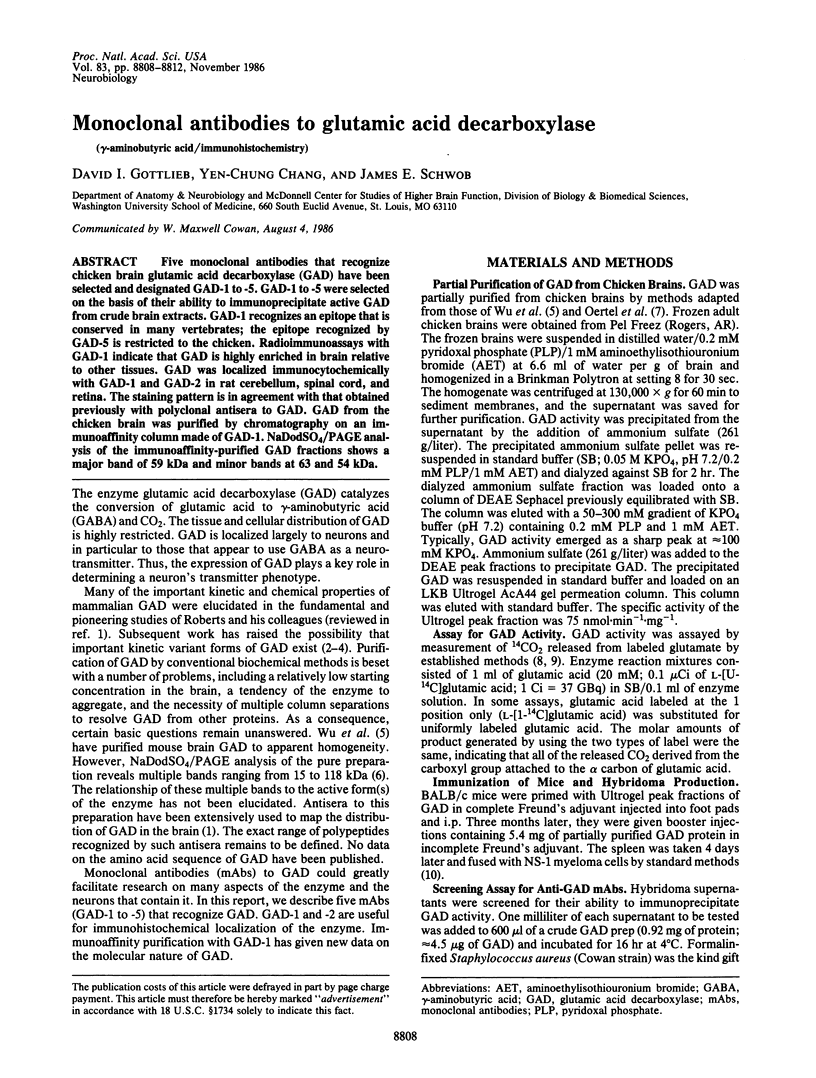
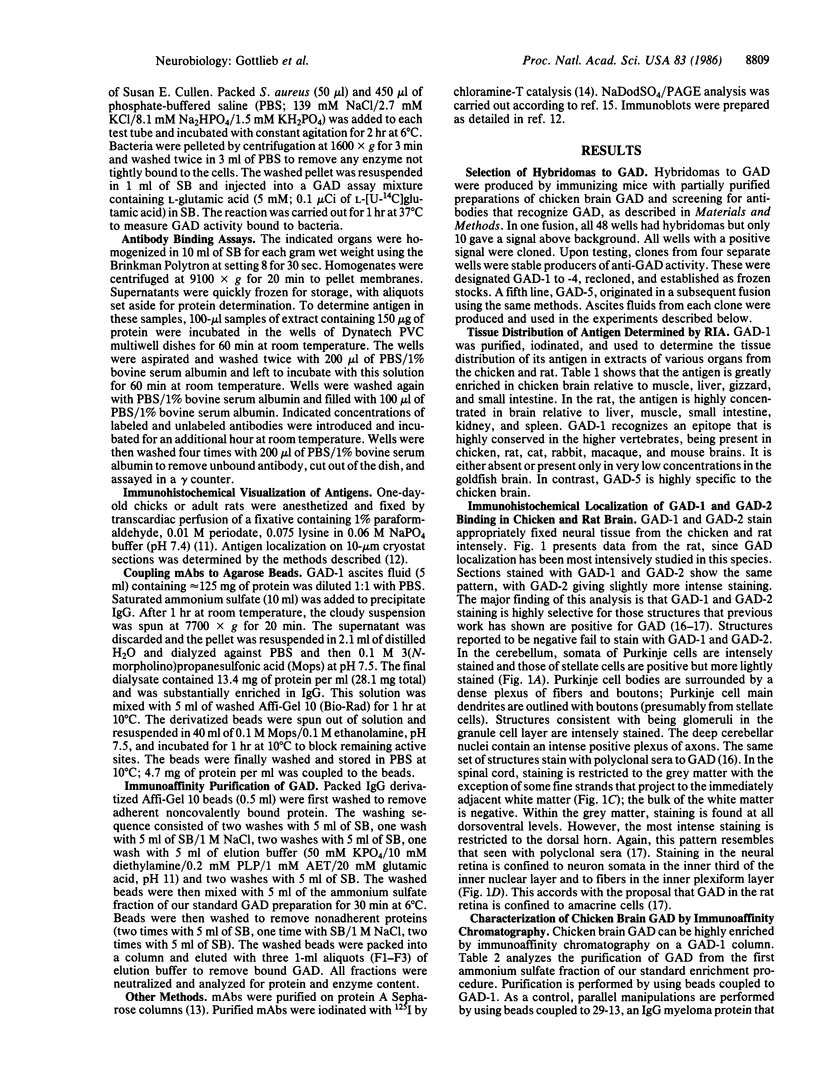
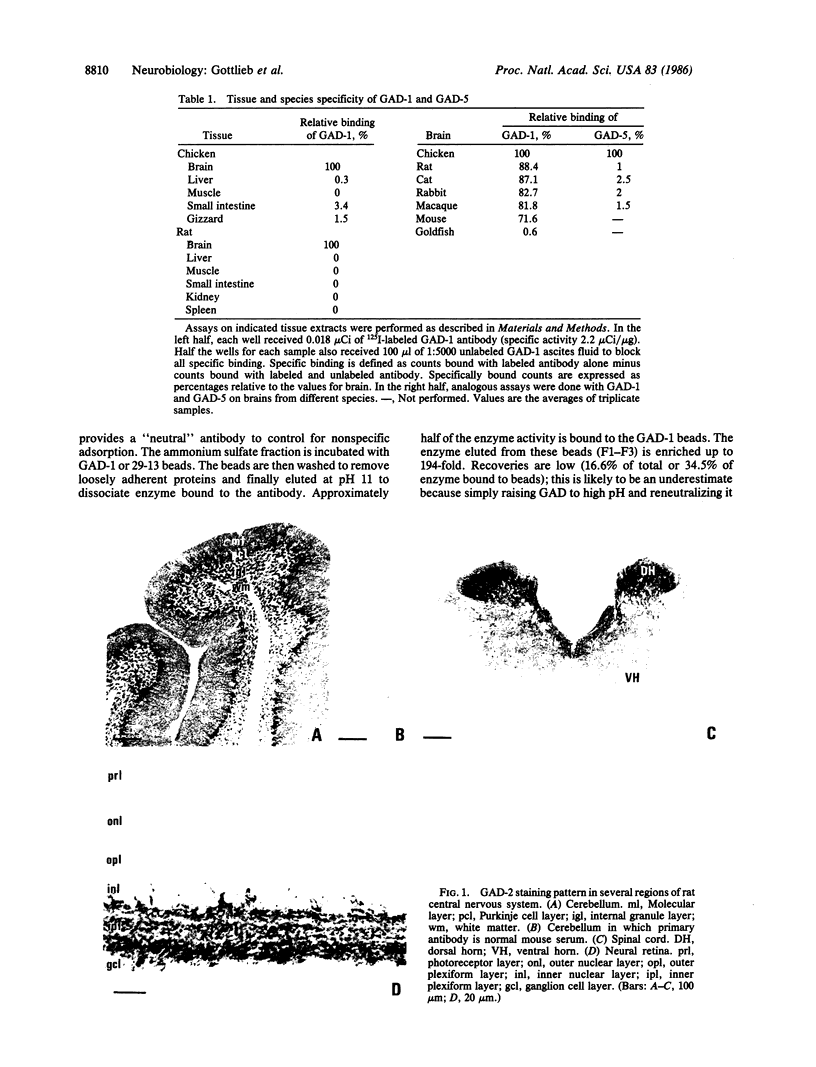
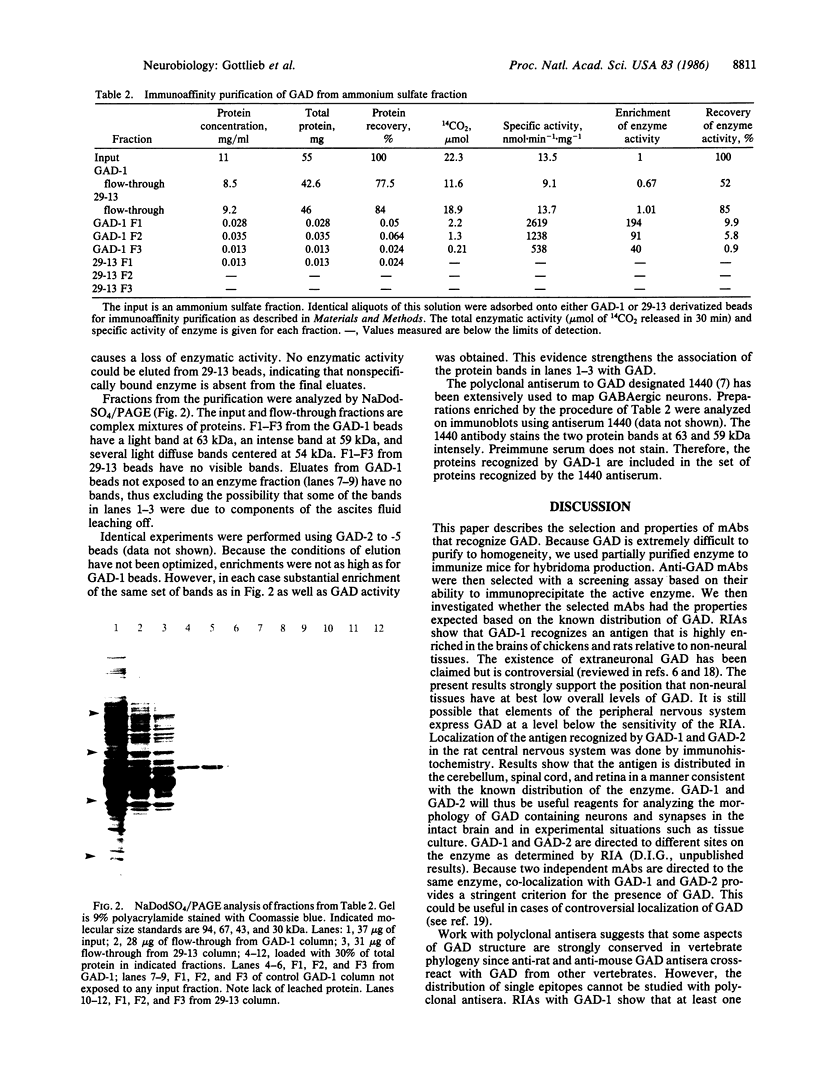
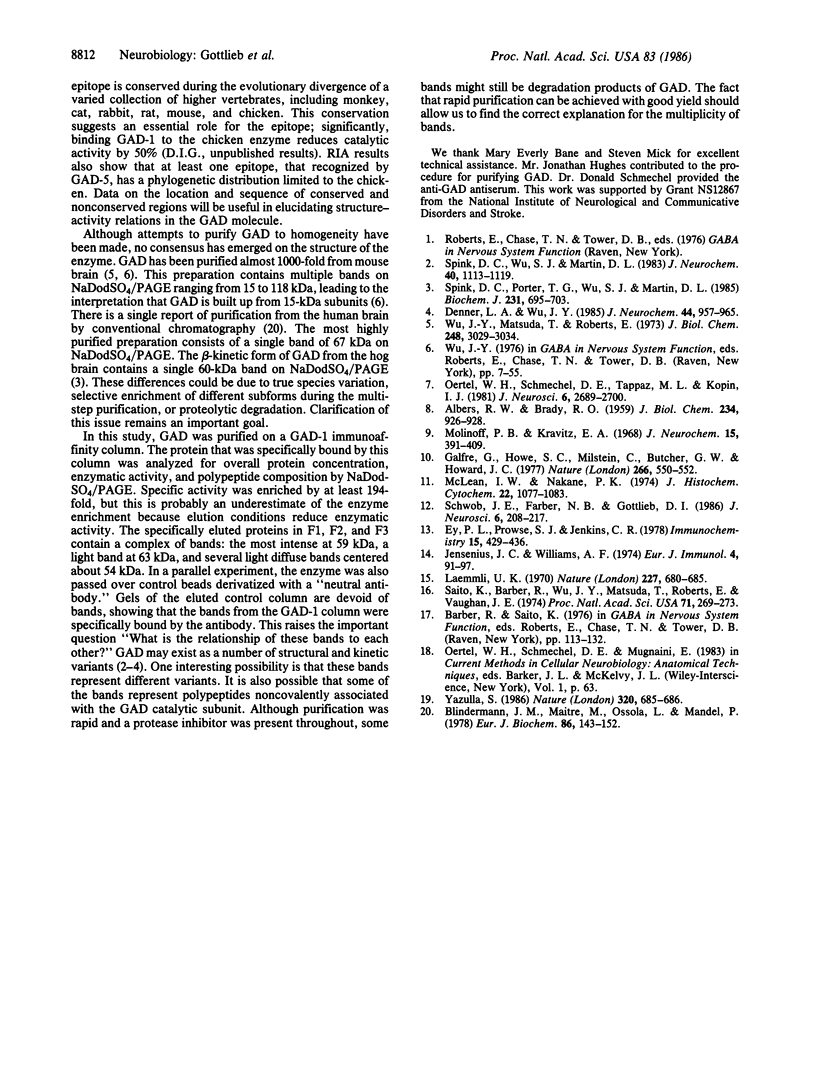
Images in this article
Selected References
These references are in PubMed. This may not be the complete list of references from this article.
- ALBERS R. W., BRADY R. O. The distribution of glutamic decarboxylase in the nervous system of the rhesus monkey. J Biol Chem. 1959 Apr;234(4):926–928. [PubMed] [Google Scholar]
- Blindermann J. M., Maitre M., Ossola L., Mandel P. Purification and some properties of L-glutamate decarboxylase from human brain. Eur J Biochem. 1978 May;86(1):143–152. doi: 10.1111/j.1432-1033.1978.tb12293.x. [DOI] [PubMed] [Google Scholar]
- Denner L. A., Wu J. Y. Two forms of rat brain glutamic acid decarboxylase differ in their dependence on free pyridoxal phosphate. J Neurochem. 1985 Mar;44(3):957–965. doi: 10.1111/j.1471-4159.1985.tb12910.x. [DOI] [PubMed] [Google Scholar]
- Ey P. L., Prowse S. J., Jenkin C. R. Isolation of pure IgG1, IgG2a and IgG2b immunoglobulins from mouse serum using protein A-sepharose. Immunochemistry. 1978 Jul;15(7):429–436. doi: 10.1016/0161-5890(78)90070-6. [DOI] [PubMed] [Google Scholar]
- Galfre G., Howe S. C., Milstein C., Butcher G. W., Howard J. C. Antibodies to major histocompatibility antigens produced by hybrid cell lines. Nature. 1977 Apr 7;266(5602):550–552. doi: 10.1038/266550a0. [DOI] [PubMed] [Google Scholar]
- Jensenius J. C., Williams A. F. The binding of anti-immunoglobulin antibodies to rat thymocytes and thoracic duct lymphocytes. Eur J Immunol. 1974 Feb;4(2):91–97. doi: 10.1002/eji.1830040207. [DOI] [PubMed] [Google Scholar]
- Laemmli U. K. Cleavage of structural proteins during the assembly of the head of bacteriophage T4. Nature. 1970 Aug 15;227(5259):680–685. doi: 10.1038/227680a0. [DOI] [PubMed] [Google Scholar]
- McLean I. W., Nakane P. K. Periodate-lysine-paraformaldehyde fixative. A new fixation for immunoelectron microscopy. J Histochem Cytochem. 1974 Dec;22(12):1077–1083. doi: 10.1177/22.12.1077. [DOI] [PubMed] [Google Scholar]
- Molinoff P. B., Kravitz E. A. The metabolism of gamma-aminobutyric acid (GABA) in the lobster nervous system--glutamic decarboxylase. J Neurochem. 1968 May;15(5):391–409. doi: 10.1111/j.1471-4159.1968.tb11626.x. [DOI] [PubMed] [Google Scholar]
- Oertel W. H., Schmechel D. E., Tappaz M. L., Kopin I. J. Production of a specific antiserum to rat brain glutamic acid decarboxylase by injection of an antigen-antibody complex. Neuroscience. 1981;6(12):2689–2700. doi: 10.1016/0306-4522(81)90113-5. [DOI] [PubMed] [Google Scholar]
- Saito K., Barber R., Wu J., Matsuda T., Roberts E., Vaughn J. E. Immunohistochemical localization of glutamate decarboxylase in rat cerebellum. Proc Natl Acad Sci U S A. 1974 Feb;71(2):269–273. doi: 10.1073/pnas.71.2.269. [DOI] [PMC free article] [PubMed] [Google Scholar]
- Schwob J. E., Farber N. B., Gottlieb D. I. Neurons of the olfactory epithelium in adult rats contain vimentin. J Neurosci. 1986 Jan;6(1):208–217. doi: 10.1523/JNEUROSCI.06-01-00208.1986. [DOI] [PMC free article] [PubMed] [Google Scholar]
- Spink D. C., Porter T. G., Wu S. J., Martin D. L. Characterization of three kinetically distinct forms of glutamate decarboxylase from pig brain. Biochem J. 1985 Nov 1;231(3):695–703. doi: 10.1042/bj2310695. [DOI] [PMC free article] [PubMed] [Google Scholar]
- Spink D. C., Wu S. J., Martin D. L. Multiple forms of glutamate decarboxylase in porcine brain. J Neurochem. 1983 Apr;40(4):1113–1119. doi: 10.1111/j.1471-4159.1983.tb08101.x. [DOI] [PubMed] [Google Scholar]
- Wu J. Y., Matsuda T., Roberts E. Purification and characterization of glutamate decarboxylase from mouse brain. J Biol Chem. 1973 May 10;248(9):3029–3034. [PubMed] [Google Scholar]
- Yazulla S. Neurochemistry. Is GABA the neurotransmitter for some photoreceptors? Nature. 1986 Apr 24;320(6064):685–686. doi: 10.1038/320685a0. [DOI] [PubMed] [Google Scholar]



